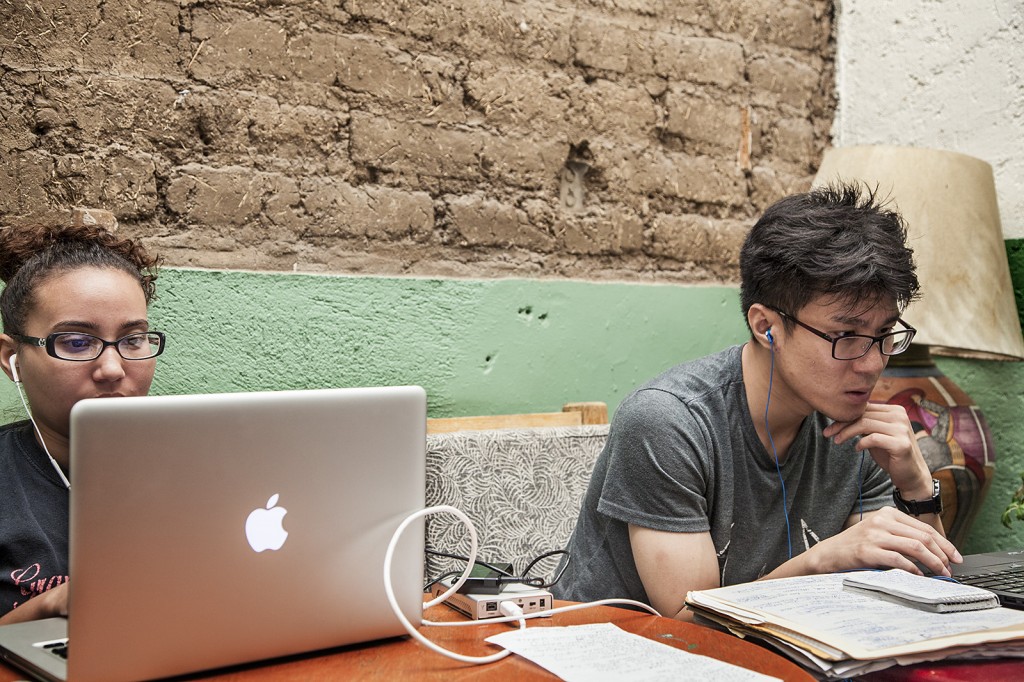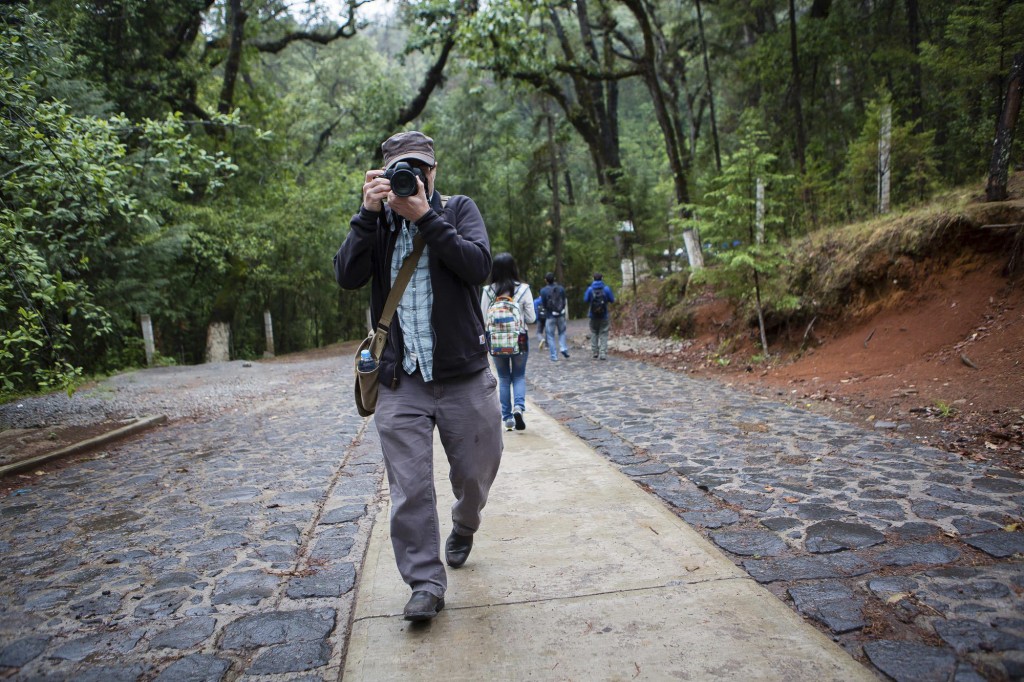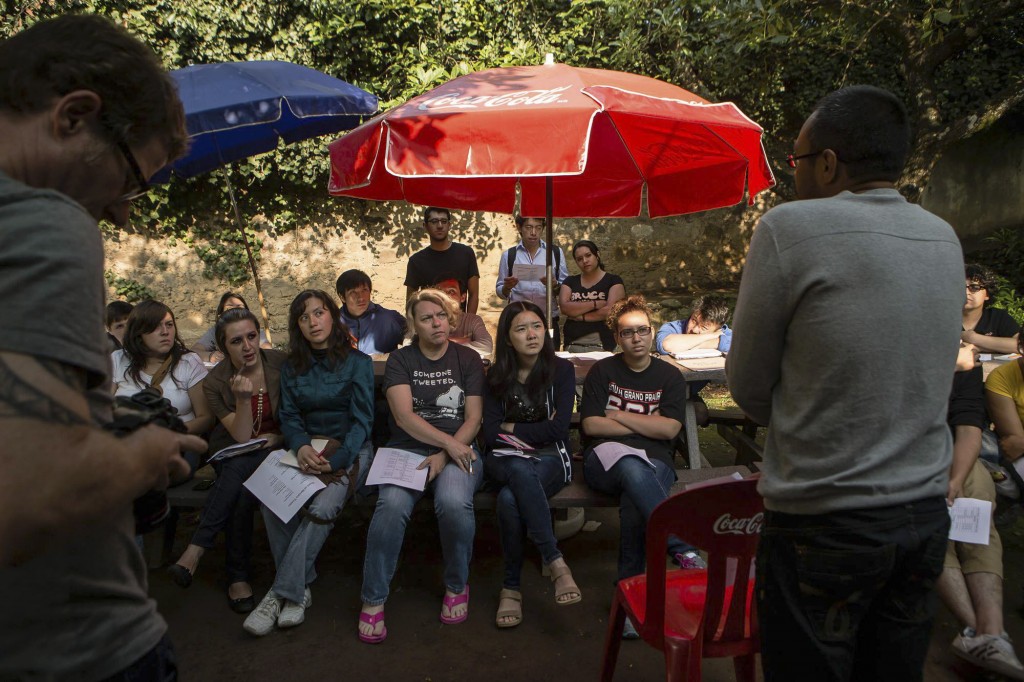Grand Ambitions, Great Rewards
By Lenin Martell
June 22, 2013: Tenancingo, Mexico
It’s a late Saturday night at Café Latte, one of the hot social meeting spots in Tenancingo. Young people arrive to chat and have a good time. My students have taken over some tables, earbuds on, and they can’t stop working in spite of the fact they have to wake up at 6 a.m. tomorrow. And it’s Sunday already. They have all come here looking for a faster wi-fi connection. They still have two days left to finish their projects, but discipline has compelled them to improve their writing and to perfect their videos and photographs. The display of commitment and ability has puzzled my colleagues from the course and me. This academic experience has become one of the greatest achievements of our careers.
Last June, three professors ventured into teaching “narrative journalism” to students from the Mayborn School of Journalism at the University of North Texas (UNT) and both the School of Political and Social Sciences and the School of Languages at the Autonomous University of the State of Mexico (UAEM). Our home base was UAEM’s satellite campus in Tenancingo.
This journey started a year ago, in May 2012. I was invited to a meeting in Toluca with faculty from UNT. We were immediately able to agree on a project: teaching a narrative journalism course in Tenancingo. The course would be taught by Mexican and American professors. Graduate and undergraduate journalism students from UNT and undergraduate communications students from UAEM would be selected to take part in this project as journalists. Students from the School of Languages would work as interpreters. A course like this had been a goal for years. In my mind this is the new teaching method of the 21st century.
Narrative non-fiction journalism is a cutting edge way of writing contemporary history, telling people’s everyday stories using literary techniques. The goal was to understand complex realities through people’s own experiences, not through what a government official or any ‘important’ character proclaims.
I’ve long thought that narrative journalism is necessary to help understand major issues such as poverty, unemployment, injustice, inequity and organized crime. In our country there’s little tradition for this kind of writing. In fact, courses on this matter are nonexistent, all the more reason this joint project with UNT thrills me.
Three weeks later, on June 4, 2012 I was at UNT ready to plan this course along with my colleague Thorne Anderson. First we had to know the human and material resources we had at hand. That summer I taught at UNT’s Department of Radio, Television and Film, which really helped me understand the qualities Texan students had to venture into this international experience.
We worked for almost a year, through May 2013. Emails would come and go with questions that seemed unanswerable, and phone calls became recurrent. Manuel Garduño, head of the UNT-UAEM liaison office, solved our concerns. When I found out Thorne had invited the Sunday editor of the Dallas Morning News, Tom Huang, to join our faculty I got excited. I had met Tom in July 2010 in a workshop on narrative essays.
Tom’s a good listener and a keen observer. He is analytical and didactic. His serious questioning provides effective feedback. He teaches journalism workshops at the prestigious Poynter Institute in Florida, and he’s considered one of the best editors in the country.
Working from our main campus in Toluca we marshaled resources for the project.
The Schools of Languages and Political Sciences, the Department of Research, and the UAEM Campus in Tenancingo all pitched in to bring this international course together. A great vibe of professionalism and willingness was prevalent in both the Texan and Mexican teams, a vibe which I have hardly ever experienced in my entire career.
To recruit students I designed a course on narrative journalism to introduce them to narrative concepts which are not part of their normal course of studies. Some students in the project were drawn from the Writing Center in the School of Political and Social Sciences. By June, 2013 the Mexican students were ready, and we traveled to the south of the state.
The course started on June 4. There was much anticipation from both teachers and students, as this challenge required a gargantuan, ongoing problem solving capacity. As much as we had planned beforehand, our students’ cultural universes were quite different, and the project was a new experience for all of us.
Our first week was devoted to intensive training. Each daily session was divided into three stages. Tom’s aim was to deepen the structure of narrative storytelling from a writer’s perspective. Thorne addressed narrative through multimedia, and I taught aspects of Mexico’s cultural history, to better inform students’ story selection and storytelling. In the morning we had theory; in the afternoon students scouted in Tenancingo for interesting characters for their stories. Multimedia producers (video and still photographers), writers and interpreters worked together in six teams and completed assigned exercises. In the late afternoon, we reconvened on campus for critique sessions with the teams. It was hard work, approximately 12 hours for students and 15 hours for teachers each day. No one complained. We were all eager to learn and help each other. The teams’ motivation increased and students proved capable of incorporating knowledge quickly.
However, differences were evident: Texan students were more organized, disciplined, and punctual, showed working capability and self-confidence, while Mexican students were more able to immerse themselves in the local scene and solve problems creatively and spontaneously. Recognizing these differences allowed instructors to work closer with students and assess them individually. Communication and feedback were essential in order for the students to carry on with their work.
For the following two weeks students were immersed in Tenancingo and Malinalco to work on their stories. Volunteer families from the two towns hosted them and although some students were reluctant to venture into this part of the journey, the host families’ kind hospitality eased all fears. Hosts’ support played a key role in students’ motivation.
In the last week of the course all students returned to the Tenancingo campus to edit their material, and in most cases their stories needed a lot of improvement. For many, that week was a sleepless one. But one thing was sure: students were growing and learning from their stories. Karen Davila who had worked on the story of an impoverished family said, “We complain so much about our lives but we don’t see that there are people who are in worse situations than we are.”
The course finished on June 26. When I said goodbye to each of the students, I noticed that not only had they learned to tell stories, but they had changed as individuals. They were more self-confident, and they were more professionally skilled, more competitive, and more disciplined to work in the international arena. Belem Ortiz, who wrote the incredible story of a woman on a mission to save all the stray dogs of Malinalco, confirmed this by saying, “This is my first experience in narrative journalism, and it has changed my life, not only for the commitment this project represented, but for the commitment that in turn I’ll assume in every aspect of my life because of it. Working with people in this way is what I want to do the rest of my life.”
In Tenancingo, Tom, Thorne and I saw many of our dreams as teachers and journalists crystallized. New international academic projects have begun, as well as close friendships. Above all, this was an exercise which confirmed that a well-designed academic project can deeply transform 21st century youth. Great effort is required, but there’s great joy in return.



